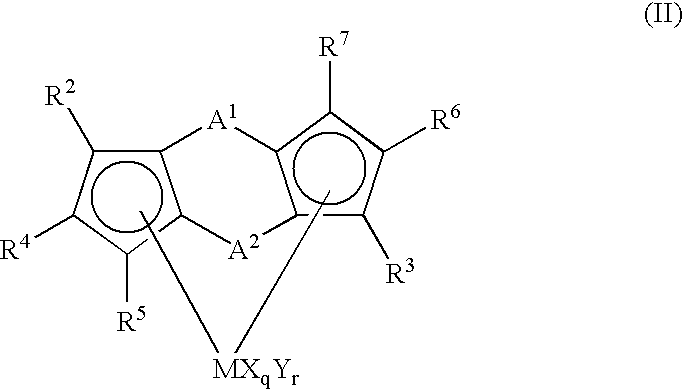Propylene polymers and resin composition and molding containing the polymers
a technology of polymer and resin composition, which is applied in the field of propylene polymer, and a resin composition, a molded product and a resin modifier composed of the polymer, can solve the problems of poor surface characteristics of the resulting molded product and the risk of causing various problems, and achieve excellent softness and transparency, and less stickiness
- Summary
- Abstract
- Description
- Claims
- Application Information
AI Technical Summary
Benefits of technology
Problems solved by technology
Method used
Image
Examples
example 1
Propylene Homopolymer
(1) Preparation of catalyst: Synthesis of (1,2′-dimethylsilylene)(2, 1′-dimethylsilylene)bis(3-n-butylindenyl) zirconium dichloride
[0339]0.83 g of (1,2′-dimethylsilylene)(2,1′-dimethylsilylene)bis(indene) (2.4 mmol) and 50 ml of ether were charged into a Schlenk's bottle. After cooling to −78° C. and adding 3.1 ml (5.0 mmol) of n-BuLi (as 1.6 M hexane solution), the mixture was stirred for 12 hours at room temperature. Then, the mixture was distilled to remove the solvent therefrom, and the obtained solids were washed with 20 ml of hexane to obtain 1.1 g (2.3 mmol) of a lithium salt as an ether adduct. The thus obtained lithium salt was dissolved in 50 ml of THF and cooled to −78° C. 0.57 ml (5.3 mmol) of n-butyl bromide was slowly dropped in the resulting solution, followed by stirring for 12 hours at room temperature. The solution is distilled to remove the solvent therefrom. The obtained residues were extracted with 50 ml of hexane, and the solvent was distil...
example 1a
[0351]400 ml of toluene, 0.5 mmol of TIBA and 1 mmol of methyl aluminoxane were charged into a heat-dried 1-liter autoclave at room temperature in nitrogen atmosphere. After raising the temperature to 50° C. while stirring, 1 μmol of (1,2′-dimethylsilylene)(2,1′-dimethylsilylene)bis(3-n-butylindenyl)zirconium dichloride was added to the autoclave. Then, propylene was supplied to the autoclave and polymerized for one hour while holding the inside pressure of the autoclave at 0.7 MPa (gauge). After completion of the polymerization reaction, the reaction product was charged into a methanol-hydrochloric acid solution, and after fully stirring, the mixture was filtered. The obtained solids were fully washed with methanol, and then dried to obtain 19.5 g of isotactic polypropylene. It was confirmed that the W25 of the resulting polymer was 90 wt %; the H25 was 15 wt %; the melting temperature (Tm) was 71.5° C.; ΔH was 13.1 J / g; the value of 3×(Tm-120) was −145.5; the mmmm fraction was 44....
example 2
Propylene Homopolymer
[0352]Propylene homopolymer was produced in the same manner as in EXAMPLE 1 except that no hydrogen was introduced. The results are shown in Table 2.
PUM
| Property | Measurement | Unit |
|---|---|---|
| Tm | aaaaa | aaaaa |
| temperature- | aaaaa | aaaaa |
| molecular weight distribution | aaaaa | aaaaa |
Abstract
Description
Claims
Application Information
 Login to View More
Login to View More - R&D
- Intellectual Property
- Life Sciences
- Materials
- Tech Scout
- Unparalleled Data Quality
- Higher Quality Content
- 60% Fewer Hallucinations
Browse by: Latest US Patents, China's latest patents, Technical Efficacy Thesaurus, Application Domain, Technology Topic, Popular Technical Reports.
© 2025 PatSnap. All rights reserved.Legal|Privacy policy|Modern Slavery Act Transparency Statement|Sitemap|About US| Contact US: help@patsnap.com



